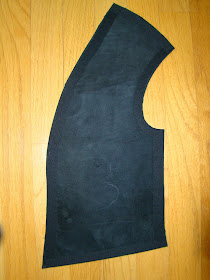The value of this leather dress lies in the usage of large leather panels, as well as custom fit. I frequently see leather dresses in designer shows, with price tags of several thousand dollars. A high price point is associated with large leather panels and minimal piecing. My dress has twelve leather panels: six in the bodice and six in the skirt. The skirt features particularly large leather panels. A similar dress at a lower price point could have double the number of panels to reduce the amount of leather required.
My original concept for the black leather dress was a princess seam bodice,short set-in sleeves, and a skirt with deep pleats along the princess seams. The muslin is below.
 |
| First muslin design was rejected |
The muslin dress was boring, even frumpy. I realized that a more narrow style was required. I found an interesting pattern in the Autumn/Winter 2014 Burda Easy magazine. The pattern has an inverted triangle inserted into the bodice center, and a triangle inserted into the skirt center. Darts are incorporated into the seams that join the triangles to the fronts and backs. The shaping was not fitted enough for my taste, and the photo below shows pins removing excess fabric from the bust to the waist at center front.
 |
| Sheath style dress with triangular insets is interesting; pattern #4G |
In the above photo, I pinned out excess fabric in an angled manner because I was tired and not thinking clearly. The next day, I straightened the excess fabric into vertical darts below.
 |
| I added front darts to define the garment waist more |
The dress back needed a sway back adjustment as evidenced by the row of horizontal pins at the waist back. I didn't add darts to the garment back.
 |
| Sway back adjustment is needed |
The sway back adjustment caused the side sides to no longer hang straight. They noticeably swung to the back.
 |
| Side seams are swinging to the back rather than straight down |
Here are the #4G pattern pieces: Front, Bodice Front Inset, Skirt Front Inset, Bodice Back Inset, Skirt Back Inset, and Back. Later I added a narrow, one piece short sleeve with zero sleeve cap ease.
 |
| Burda 4G pattern tissue |
As recommended by the University of Fashion leather sewing series, I applied fusible tape along all garment edges to control stretch during sewing. The triangular insets are fully interfaced, but the rest of the leather pieces have fusible tape only along the seam and hem allowances.
 |
| 3/4" fusible tape, 1/2" seam allowances, 2" hem allowances |
To control bulk, I used lapped seams for the triangular insets. First I chalk marked the stitching lines on the fashion side of the leather.
 |
| Dress Back |
I used Sobo Glue, but other people like Barge cement.
 |
| Glue basting for precise panel placement |
The triangular insets were glued in place, then edge-stitched and top-stitched in place once the glue was dry.
 |
| I let the garment back dry before top-stitching the triangular inset panels |
Below is the bodice front. I made sure that the glue process maintained a curved shape over the bust line. There is a dressmaker's ham underneath to help shape the garment as the glue dries.
 |
| Glue curves into the garment as needed |
 |
| Detail of Skirt Back Inset |
 |
| Detail of Bodice Back Inset |
|
After this project and the silver leather jacket sewn in September, I feel that's enough leather for a while. I am looking forward to sewing Fall jackets and a coat with woven fabrics.















Your dress is absolutely stunning! I'm a new reader and really enjoy your blog.
ReplyDeleteWow wow wow!
ReplyDeleteThis is truly amazing. I love the triangular insets. Amazing work.
ReplyDeleteGorgeous! Impeccable workmanship.
ReplyDeleteI love this! Your design changes make this dress so much more exciting.
ReplyDeleteYour blog has been an inspiration for awhile now. Thanks so much!